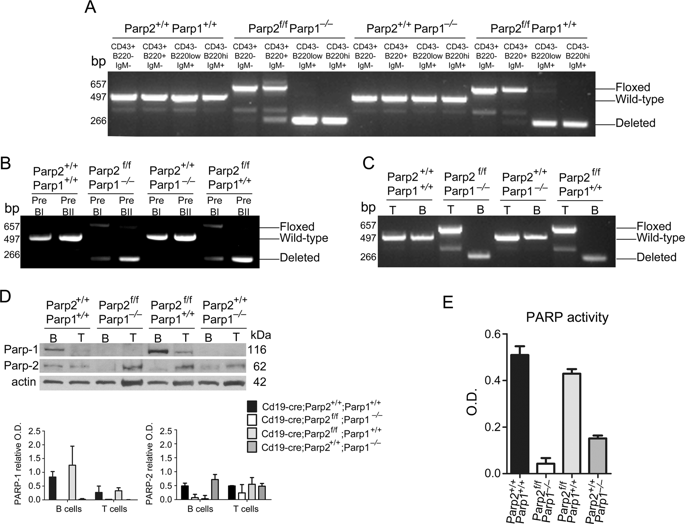当前位置:
X-MOL 学术
›
Cell Death Differ.
›
论文详情
Our official English website, www.x-mol.net, welcomes your
feedback! (Note: you will need to create a separate account there.)
Coordinated signals from the DNA repair enzymes PARP-1 and PARP-2 promotes B-cell development and function.
Cell Death and Differentiation ( IF 13.7 ) Pub Date : 2019-04-17 , DOI: 10.1038/s41418-019-0326-5 Miguel A Galindo-Campos 1 , Marie Bedora-Faure 2 , Jordi Farrés 1 , Chloé Lescale 2 , Lucia Moreno-Lama 1 , Carlos Martínez 3 , Juan Martín-Caballero 4 , Coral Ampurdanés 1 , Pedro Aparicio 5 , Françoise Dantzer 6 , Andrea Cerutti 7, 8 , Ludovic Deriano 2 , José Yélamos 1, 9
Cell Death and Differentiation ( IF 13.7 ) Pub Date : 2019-04-17 , DOI: 10.1038/s41418-019-0326-5 Miguel A Galindo-Campos 1 , Marie Bedora-Faure 2 , Jordi Farrés 1 , Chloé Lescale 2 , Lucia Moreno-Lama 1 , Carlos Martínez 3 , Juan Martín-Caballero 4 , Coral Ampurdanés 1 , Pedro Aparicio 5 , Françoise Dantzer 6 , Andrea Cerutti 7, 8 , Ludovic Deriano 2 , José Yélamos 1, 9
Affiliation

|
Poly (ADP-ribose) polymerase (PARP)-1 and PARP-2 regulate the function of various DNA-interacting proteins by transferring ADP-ribose emerging from catalytic cleavage of cellular β-NAD+. Hence, mice lacking PARP-1 or PARP-2 show DNA perturbations ranging from altered DNA integrity to impaired DNA repair. These effects stem from the central role that PARP-1 and PARP-2 have on the cellular response to DNA damage. Failure to mount a proper response culminates in cell death. Accordingly, PARP inhibitors are emerging as promising drugs in cancer therapy. However, the full impact of these inhibitors on immunity, including B-cell antibody production, remains elusive. Given that mice carrying dual PARP-1 and PARP-2 deficiency develop early embryonic lethality, we crossed PARP-1-deficient mice with mice carrying a B-cell-conditional PARP-2 gene deletion. We found that the resulting dually PARP-1 and PARP-2-deficient mice had perturbed bone-marrow B-cell development as well as profound peripheral depletion of transitional and follicular but not marginal zone B-cells. Of note, bone-marrow B-cell progenitors and peripheral mature B-cells were conserved in mice carrying either PARP-1 or PARP-2 deficiency. In dually PARP-1 and PARP-2-deficient mice, B-cell lymphopenia was associated with increased DNA damage and accentuated death in actively proliferating B-cells. Moreover, dual PARP-1 and PARP-2 deficiency impaired antibody responses to T-independent carbohydrate but not to T-dependent protein antigens. Notwithstanding the pivotal role of PARP-1 and PARP-2 in DNA repair, combined PARP-1 and PARP-2 deficiency did not perturb the DNA-editing processes required for the generation of a protective antibody repertoire, including Ig V(D)J gene recombination and IgM-to-IgG class switching. These findings provide key information as to the potential impact of PARP inhibitors on humoral immunity, which will facilitate the development of safer PARP-targeting regimens against cancer.
中文翻译:

来自 DNA 修复酶 PARP-1 和 PARP-2 的协调信号促进 B 细胞发育和功能。
聚 (ADP-核糖) 聚合酶 (PARP)-1 和 PARP-2 通过转移细胞 β-NAD+ 催化裂解产生的 ADP-核糖来调节各种 DNA 相互作用蛋白的功能。因此,缺乏 PARP-1 或 PARP-2 的小鼠表现出从 DNA 完整性改变到 DNA 修复受损的 DNA 扰动。这些影响源于 PARP-1 和 PARP-2 在细胞对 DNA 损伤的反应中的核心作用。未能做出适当的反应最终导致细胞死亡。因此,PARP抑制剂正在成为癌症治疗中很有前景的药物。然而,这些抑制剂对免疫的全面影响,包括 B 细胞抗体的产生,仍然难以捉摸。鉴于携带 PARP-1 和 PARP-2 双重缺陷的小鼠会发展为早期胚胎致死率,我们将 PARP-1 缺陷小鼠与携带 B 细胞条件性 PARP-2 基因缺失的小鼠杂交。我们发现,由此产生的 PARP-1 和 PARP-2 双重缺陷小鼠扰乱了骨髓 B 细胞的发育,以及过渡区和滤泡区 B 细胞的严重外周消耗,但边缘区 B 细胞没有。值得注意的是,骨髓 B 细胞祖细胞和外周成熟 B 细胞在携带 PARP-1 或 PARP-2 缺陷的小鼠中是保守的。在 PARP-1 和 PARP-2 双重缺陷小鼠中,B 细胞淋巴细胞减少症与活跃增殖的 B 细胞中 DNA 损伤增加和死亡加重有关。此外,PARP-1 和 PARP-2 双重缺乏会损害抗体对 T 非依赖性碳水化合物的反应,但不会损害对 T 依赖性蛋白抗原的反应。尽管 PARP-1 和 PARP-2 在 DNA 修复中起关键作用,PARP-1 和 PARP-2 的联合缺陷不会干扰产生保护性抗体库所需的 DNA 编辑过程,包括 Ig V(D)J 基因重组和 IgM 到 IgG 类别转换。这些发现提供了有关 PARP 抑制剂对体液免疫的潜在影响的关键信息,这将有助于开发更安全的 PARP 靶向抗癌方案。
更新日期:2019-05-16
中文翻译:

来自 DNA 修复酶 PARP-1 和 PARP-2 的协调信号促进 B 细胞发育和功能。
聚 (ADP-核糖) 聚合酶 (PARP)-1 和 PARP-2 通过转移细胞 β-NAD+ 催化裂解产生的 ADP-核糖来调节各种 DNA 相互作用蛋白的功能。因此,缺乏 PARP-1 或 PARP-2 的小鼠表现出从 DNA 完整性改变到 DNA 修复受损的 DNA 扰动。这些影响源于 PARP-1 和 PARP-2 在细胞对 DNA 损伤的反应中的核心作用。未能做出适当的反应最终导致细胞死亡。因此,PARP抑制剂正在成为癌症治疗中很有前景的药物。然而,这些抑制剂对免疫的全面影响,包括 B 细胞抗体的产生,仍然难以捉摸。鉴于携带 PARP-1 和 PARP-2 双重缺陷的小鼠会发展为早期胚胎致死率,我们将 PARP-1 缺陷小鼠与携带 B 细胞条件性 PARP-2 基因缺失的小鼠杂交。我们发现,由此产生的 PARP-1 和 PARP-2 双重缺陷小鼠扰乱了骨髓 B 细胞的发育,以及过渡区和滤泡区 B 细胞的严重外周消耗,但边缘区 B 细胞没有。值得注意的是,骨髓 B 细胞祖细胞和外周成熟 B 细胞在携带 PARP-1 或 PARP-2 缺陷的小鼠中是保守的。在 PARP-1 和 PARP-2 双重缺陷小鼠中,B 细胞淋巴细胞减少症与活跃增殖的 B 细胞中 DNA 损伤增加和死亡加重有关。此外,PARP-1 和 PARP-2 双重缺乏会损害抗体对 T 非依赖性碳水化合物的反应,但不会损害对 T 依赖性蛋白抗原的反应。尽管 PARP-1 和 PARP-2 在 DNA 修复中起关键作用,PARP-1 和 PARP-2 的联合缺陷不会干扰产生保护性抗体库所需的 DNA 编辑过程,包括 Ig V(D)J 基因重组和 IgM 到 IgG 类别转换。这些发现提供了有关 PARP 抑制剂对体液免疫的潜在影响的关键信息,这将有助于开发更安全的 PARP 靶向抗癌方案。

















































 京公网安备 11010802027423号
京公网安备 11010802027423号